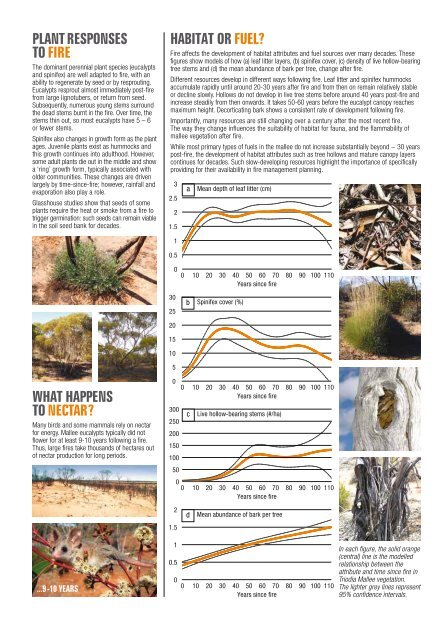Fire and Wildlife in the Mallee - Eyre Peninsula Natural Resources ...
Fire and Wildlife in the Mallee - Eyre Peninsula Natural Resources ...
Fire and Wildlife in the Mallee - Eyre Peninsula Natural Resources ...
- No tags were found...
Create successful ePaper yourself
Turn your PDF publications into a flip-book with our unique Google optimized e-Paper software.
Plant responses<br />
to fire<br />
The dom<strong>in</strong>ant perennial plant species (eucalypts<br />
<strong>and</strong> sp<strong>in</strong>ifex) are well adapted to fire, with an<br />
ability to regenerate by seed or by resprout<strong>in</strong>g.<br />
Eucalypts resprout almost immediately post-fire<br />
from large lignotubers, or return from seed.<br />
Subsequently, numerous young stems surround<br />
<strong>the</strong> dead stems burnt <strong>in</strong> <strong>the</strong> fire. Over time, <strong>the</strong><br />
stems th<strong>in</strong> out, so most eucalypts have 5 – 6<br />
or fewer stems.<br />
Sp<strong>in</strong>ifex also changes <strong>in</strong> growth form as <strong>the</strong> plant<br />
ages. Juvenile plants exist as hummocks <strong>and</strong><br />
this growth cont<strong>in</strong>ues <strong>in</strong>to adulthood. However,<br />
some adult plants die out <strong>in</strong> <strong>the</strong> middle <strong>and</strong> show<br />
a ‘r<strong>in</strong>g’ growth form, typically associated with<br />
older communities. These changes are driven<br />
largely by time-s<strong>in</strong>ce-fire; however, ra<strong>in</strong>fall <strong>and</strong><br />
evaporation also play a role.<br />
Glasshouse studies show that seeds of some<br />
plants require <strong>the</strong> heat or smoke from a fire to<br />
trigger germ<strong>in</strong>ation: such seeds can rema<strong>in</strong> viable<br />
<strong>in</strong> <strong>the</strong> soil seed bank for decades.<br />
Habitat or fuel<br />
<strong>Fire</strong> affects <strong>the</strong> development of habitat attributes <strong>and</strong> fuel sources over many decades. These<br />
figures show models of how (a) leaf litter layers, (b) sp<strong>in</strong>ifex cover, (c) density of live hollow-bear<strong>in</strong>g<br />
tree stems <strong>and</strong> (d) <strong>the</strong> mean abundance of bark per tree, change after fire.<br />
Different resources develop <strong>in</strong> different ways follow<strong>in</strong>g fire. Leaf litter <strong>and</strong> sp<strong>in</strong>ifex hummocks<br />
accumulate rapidly until around 20-30 years after fire <strong>and</strong> from <strong>the</strong>n on rema<strong>in</strong> relatively stable<br />
or decl<strong>in</strong>e slowly. Hollows do not develop <strong>in</strong> live tree stems before around 40 years post-fire <strong>and</strong><br />
<strong>in</strong>crease steadily from <strong>the</strong>n onwards. It takes 50-60 years before <strong>the</strong> eucalypt canopy reaches<br />
maximum height. Decorticat<strong>in</strong>g bark shows a consistent rate of development follow<strong>in</strong>g fire.<br />
Importantly, many resources are still chang<strong>in</strong>g over a century after <strong>the</strong> most recent fire.<br />
The way <strong>the</strong>y change <strong>in</strong>fluences <strong>the</strong> suitability of habitat for fauna, <strong>and</strong> <strong>the</strong> flammability of<br />
mallee vegetation after fire.<br />
While most primary types of fuels <strong>in</strong> <strong>the</strong> mallee do not <strong>in</strong>crease substantially beyond ~ 30 years<br />
post-fire, <strong>the</strong> development of habitat attributes such as tree hollows <strong>and</strong> mature canopy layers<br />
cont<strong>in</strong>ues for decades. Such slow-develop<strong>in</strong>g resources highlight <strong>the</strong> importance of specifically<br />
provid<strong>in</strong>g for <strong>the</strong>ir availability <strong>in</strong> fire management plann<strong>in</strong>g.<br />
3<br />
2.5<br />
2<br />
1.5<br />
a<br />
Mean depth of leaf litter (cm)<br />
1<br />
0.5<br />
0<br />
0 10 20 30 40 50 60 70 80 90 100 110<br />
Years s<strong>in</strong>ce fire<br />
30<br />
25<br />
20<br />
15<br />
10<br />
5<br />
b<br />
Sp<strong>in</strong>ifex cover (%)<br />
What happens<br />
to nectar<br />
Many birds <strong>and</strong> some mammals rely on nectar<br />
for energy. <strong>Mallee</strong> eucalypts typically did not<br />
flower for at least 9-10 years follow<strong>in</strong>g a fire.<br />
Thus, large fires take thous<strong>and</strong>s of hectares out<br />
of nectar production for long periods.<br />
0<br />
300<br />
250<br />
200<br />
150<br />
100<br />
50<br />
0 10 20 30 40 50 60 70 80 90 100 110<br />
Years s<strong>in</strong>ce fire<br />
c<br />
Live hollow-bear<strong>in</strong>g stems (#/ha)<br />
0<br />
0 10 20 30 40 50 60 70 80 90 100 110<br />
Years s<strong>in</strong>ce fire<br />
2<br />
1.5<br />
d<br />
Mean abundance of bark per tree<br />
...9-10 years<br />
1<br />
0.5<br />
0<br />
0 10 20 30 40 50 60 70 80 90 100 110<br />
Years s<strong>in</strong>ce fire<br />
In each figure, <strong>the</strong> solid orange<br />
(central) l<strong>in</strong>e is <strong>the</strong> modelled<br />
relationship between <strong>the</strong><br />
attribute <strong>and</strong> time s<strong>in</strong>ce fire <strong>in</strong><br />
Triodia <strong>Mallee</strong> vegetation.<br />
The lighter grey l<strong>in</strong>es represent<br />
95% confidence <strong>in</strong>tervals.
















